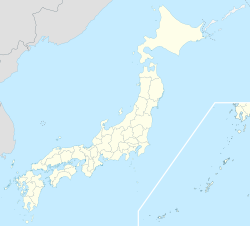Iwaizumi, Iwate
|
Iwaizumi 岩泉町 |
|||
|---|---|---|---|
| Town | |||

Iwaizumi Town Hall
|
|||
|
|||
 Location of Iwaizumi in Iwate Prefecture |
|||
| Coordinates: 39°51′N 141°48′E / 39.850°N 141.800°ECoordinates: 39°51′N 141°48′E / 39.850°N 141.800°E | |||
| Country | Japan | ||
| Region | Tōhoku | ||
| Prefecture | Iwate | ||
| District | Shimohei | ||
| Area | |||
| • Total | 992.90 km2 (383.36 sq mi) | ||
| Population (February 2014) | |||
| • Total | 10,007 | ||
| • Density | 10.1/km2 (26/sq mi) | ||
| Time zone | Japan Standard Time (UTC+9) | ||
| City symbols | |||
| • Tree | Pinus densiflora | ||
| • Flower | Paulownia tomentosa | ||
| • Bird | Copper pheasant | ||
| Phone number | 0194-22-2111 | ||
| Address | Iwaizumi-aze Sohata 59-5, Iwaizumi-chō, Shimohei-gun, Iwate 027-0595 | ||
| Website | Official website | ||
Iwaizumi (岩泉町 Iwaizumi-chō?) is a town located in Shimohei District, Iwate, Japan. As of February 2014, the town had an estimated population of 10,007 and a population density of 10.01 persons per km2. The total area was 992.91 km2.
Iwaizumi occupies the Kitakamikochi Plateau in northeast Iwate prefecture, east of the prefectural capital of Morioka. It has a small coastline. The area is mountainous, and has numerous limestone caves, including the Ryūsendō.
The area of present-day Iwaizumi was part of ancient Mutsu Province, dominated by the Nambu clan during the Edo period, who ruled Morioka Domain under the Tokugawa shogunate. The village of Iwaizumi was created within Kitahei District on April 1, 1889. Kitahei, Nakahei and Higashihei Districts were all merged into Minamihei District on March 29, 1896. Iwaizumi was elevated to town status on August 1, 1922. On September 30, 1956, Imaizumi annexed the neighboring villages of Akka, Ugei, Okawa and Omoto and on April 1, 1957 annexed the village of Kogawa to reach is present borders.
The local economy is based on agriculture and to a lesser extent on commercial fishing.
The JR East Iwaizumi Line, which connected Iwaizumi with Moichi Station on the Yamada Line, officially closed on April 1, 2014.
...
Wikipedia


